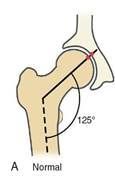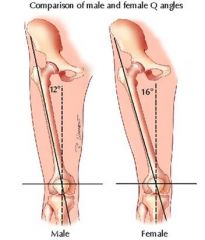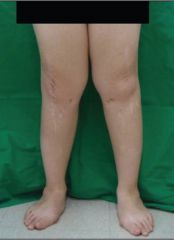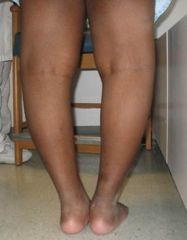![]()
![]()
![]()
Use LEFT and RIGHT arrow keys to navigate between flashcards;
Use UP and DOWN arrow keys to flip the card;
H to show hint;
A reads text to speech;
14 Cards in this Set
- Front
- Back
|
A. Femur- Angle of Inclination (Shaft of the Femur to the head of the femur)
• Normal = |
125 degrees
|
|
|
A. Femur- Angle of Inclination (Shaft of the Femur to the head of the femur)
• Coxa Vara |
(Decreased Angle)
|
|
|
A. Femur- Angle of Inclination (Shaft of the Femur to the head of the femur)
• Coxa Valga |
(Increased Angle)
|
|
|
Angle of Inclination
|

(Shaft of the Femur to the head of the femur)
|
|
|
Angle of Torsion
|
When medial and lateral condyles , as well as the greater trochanter lie on the table, and the angle that is formed from that plane and the head of the femur
|
|
|
B. Angle of Torsion (When medial and lateral condyles , as well as the greater trochanter lie on the table, and the angle that is formed from that plane and the head of the femur)
• Normal adult = |
10-20 degrees
|
|
|
B. Angle of Torsion (When medial and lateral condyles , as well as the greater trochanter lie on the table, and the angle that is formed from that plane and the head of the femur)
• Femoral Anteversion = |
Larger Angle (Severe form = Pigeon-toed)
|
|
|
B. Angle of Torsion (When medial and lateral condyles , as well as the greater trochanter lie on the table, and the angle that is formed from that plane and the head of the femur)
Femoral Retroversion = |
Straight Line
|
|
|
C. Patellofemoral Joint Forces
• When knee flexion is greater than 90 degrees you will |
generate more force on the patella , causing you to wear out the structures more quickly
|
|
|
D. Q-Angle
|

The angle that forms between the knee cap and greater trochanter (medially)
|
|
|
D. Q-Angle (The angle that forms between the knee cap and greater trochanter (medially)
• Adult Male- |
12 degrees
|
|
|
D. Q-Angle (The angle that forms between the knee cap and greater trochanter (medially)
• Adult Female- |
16 degrees (wider hips, and consequently more likely to have dislocated patella’s).
|
|
|
E. Tibiofemoral Joint
• Genu Valgum- |

- Excessive Q-angle = Touching at the knees and separated to the feet
|
|
|
E. Tibiofemoral Joint
• Genu Varum |

– Bow-legs = Thighs touching and gap from thighs to feet
|

